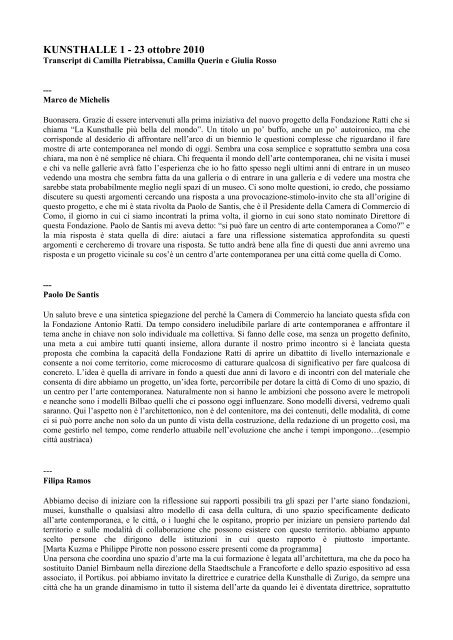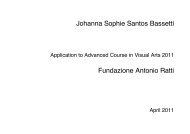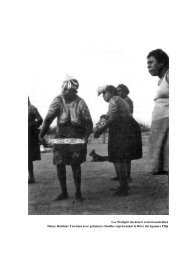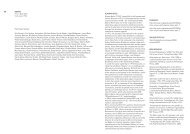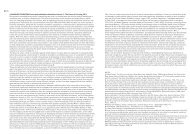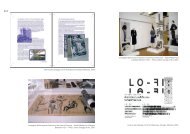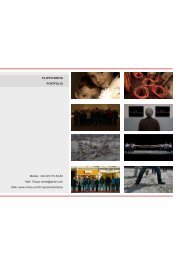KUNSTHALLE 1 - 23 ottobre 2010 - Fondazione Antonio Ratti
KUNSTHALLE 1 - 23 ottobre 2010 - Fondazione Antonio Ratti
KUNSTHALLE 1 - 23 ottobre 2010 - Fondazione Antonio Ratti
Create successful ePaper yourself
Turn your PDF publications into a flip-book with our unique Google optimized e-Paper software.
<strong>KUNSTHALLE</strong> 1 - <strong>23</strong> <strong>ottobre</strong> <strong>2010</strong><br />
Transcript di Camilla Pietrabissa, Camilla Querin e Giulia Rosso<br />
---<br />
Marco de Michelis<br />
Buonasera. Grazie di essere intervenuti alla prima iniziativa del nuovo progetto della <strong>Fondazione</strong> <strong>Ratti</strong> che si<br />
chiama “La Kunsthalle più bella del mondo”. Un titolo un po’ buffo, anche un po’ autoironico, ma che<br />
corrisponde al desiderio di affrontare nell’arco di un biennio le questioni complesse che riguardano il fare<br />
mostre di arte contemporanea nel mondo di oggi. Sembra una cosa semplice e soprattutto sembra una cosa<br />
chiara, ma non è né semplice né chiara. Chi frequenta il mondo dell’arte contemporanea, chi ne visita i musei<br />
e chi va nelle gallerie avrà fatto l’esperienza che io ho fatto spesso negli ultimi anni di entrare in un museo<br />
vedendo una mostra che sembra fatta da una galleria o di entrare in una galleria e di vedere una mostra che<br />
sarebbe stata probabilmente meglio negli spazi di un museo. Ci sono molte questioni, io credo, che possiamo<br />
discutere su questi argomenti cercando una risposta a una provocazione-stimolo-invito che sta all’origine di<br />
questo progetto, e che mi è stata rivolta da Paolo de Santis, che è il Presidente della Camera di Commercio di<br />
Como, il giorno in cui ci siamo incontrati la prima volta, il giorno in cui sono stato nominato Direttore di<br />
questa <strong>Fondazione</strong>. Paolo de Santis mi aveva detto: “si può fare un centro di arte contemporanea a Como?” e<br />
la mia risposta è stata quella di dire: aiutaci a fare una riflessione sistematica approfondita su questi<br />
argomenti e cercheremo di trovare una risposta. Se tutto andrà bene alla fine di questi due anni avremo una<br />
risposta e un progetto vicinale su cos’è un centro d’arte contemporanea per una città come quella di Como.<br />
---<br />
Paolo De Santis<br />
Un saluto breve e una sintetica spiegazione del perché la Camera di Commercio ha lanciato questa sfida con<br />
la <strong>Fondazione</strong> <strong>Antonio</strong> <strong>Ratti</strong>. Da tempo considero ineludibile parlare di arte contemporanea e affrontare il<br />
tema anche in chiave non solo individuale ma collettiva. Si fanno delle cose, ma senza un progetto definito,<br />
una meta a cui ambire tutti quanti insieme, allora durante il nostro primo incontro si è lanciata questa<br />
proposta che combina la capacità della <strong>Fondazione</strong> <strong>Ratti</strong> di aprire un dibattito di livello internazionale e<br />
consente a noi come territorio, come microcosmo di catturare qualcosa di significativo per fare qualcosa di<br />
concreto. L’idea è quella di arrivare in fondo a questi due anni di lavoro e di incontri con del materiale che<br />
consenta di dire abbiamo un progetto, un’idea forte, percorribile per dotare la città di Como di uno spazio, di<br />
un centro per l’arte contemporanea. Naturalmente non si hanno le ambizioni che possono avere le metropoli<br />
e neanche sono i modelli Bilbao quelli che ci possono oggi influenzare. Sono modelli diversi, vedremo quali<br />
saranno. Qui l’aspetto non è l’architettonico, non è del contenitore, ma dei contenuti, delle modalità, di come<br />
ci si può porre anche non solo da un punto di vista della costruzione, della redazione di un progetto così, ma<br />
come gestirlo nel tempo, come renderlo attuabile nell’evoluzione che anche i tempi impongono…(esempio<br />
città austriaca)<br />
---<br />
Filipa Ramos<br />
Abbiamo deciso di iniziare con la riflessione sui rapporti possibili tra gli spazi per l’arte siano fondazioni,<br />
musei, kunsthalle o qualsiasi altro modello di casa della cultura, di uno spazio specificamente dedicato<br />
all’arte contemporanea, e le città, o i luoghi che le ospitano, proprio per iniziare un pensiero partendo dal<br />
territorio e sulle modalità di collaborazione che possono esistere con questo territorio. abbiamo appunto<br />
scelto persone che dirigono delle istituzioni in cui questo rapporto è piuttosto importante.<br />
[Marta Kuzma e Philippe Pirotte non possono essere presenti come da programma]<br />
Una persona che coordina uno spazio d’arte ma la cui formazione è legata all’architettura, ma che da poco ha<br />
sostituito Daniel Birnbaum nella direzione della Staedtschule a Francoforte e dello spazio espositivo ad essa<br />
associato, il Portikus. poi abbiamo invitato la direttrice e curatrice della Kunsthalle di Zurigo, da sempre una<br />
città che ha un grande dinamismo in tutto il sistema dell’arte da quando lei è diventata direttrice, soprattutto
con un interesse particolare per i giovani accanto ai più affermati. Passando da lì i giovani vengono<br />
conosciuti e il lavoro di Beatrix Ruf ha portato anche un pubblico più giovane alla città di Zurigo attivando<br />
un dialogo nuovo anche con musei e altri spazi. E poi ovviamente Angela Vettese, che non ha bisogno di<br />
presentazioni e che in questo caso abbiamo invitato per la sua attività alla <strong>Fondazione</strong> Bevilacqua La Masa<br />
che ha un ruolo fondamentale nella città di Venezia, ed è molto curioso riflettere soprattutto sul rapporto coi<br />
locali di Venezia, persone che sono molto abituate all’arte e ad un contatto diretto con essa e che, nel<br />
momento in cui non c’è il grande evento della Biennale, spesso si trovano con un grande vuoto e con<br />
un’assenza di uno stile e attività culturale alla quale sono abituati e formati in quanto abitano in una città che<br />
riceve la più famosa e consolidata di tutte le Biennali mondiali. In questo contesto la Bevilacqua ha un ruolo<br />
fondamentale sia con artisti affermati che nell’attività di dialogo con i giovani, tramite residenze, borse e<br />
mostre. Riesce anche ad arrivare a contesti e tipologie di persone molto diversi.<br />
Darei la parola a NH, che farà quindi l’introduzione, e dopo tutte le presentazioni ci sarà tempo per le<br />
domande.<br />
---<br />
Nikolaus Hirsch<br />
From what i understood you are discussing in Como what art institutions or centers are to be in the city, but<br />
i’m trying to address a different perspective on what institutions building actually means. I think it is a<br />
process, not just delivering a product and drop it in the city of Como, it’s an ongoing process that actually<br />
involves many different aspects: spatial or architectural aspects, curatorial practice and last but not least<br />
artistic practice. I think also artists have to play a role in such a process. In the title of tonight’s event was<br />
mentioned the relation between the art institutions and the question of the working city and of course here we<br />
are not just talking about a european topic, i think the increasing production of art institution is a global<br />
phenomenon, and what we have witnessed in the past 10 years it’s certainly a globalization of the question of<br />
the art institution and we are seeing art institutions coming up in cities like Istanbul, through the Biennial, the<br />
construction of art centers that became a spot in the international map of the art world. Places like Dehli,<br />
India, create networks of art institutions also commissioning to famous architects. i will try to focus on a<br />
more european context because in order to understand the process of institution building it makes sense to<br />
look into the european context partly also because there has been a long tradition of the typology of the<br />
Kunsthalle. two example tonight are from germany, and the word “Kunsthalle” of course comes from the<br />
german speaking world, and i want to include also the swiss context. these two processes i’ve been involved<br />
into are: the european Kunsthalle in cologne, which was curated by its first director Nicolaus Schafhausen<br />
who’s now in Rotterdam at Witte De Witt, and the second is the Portikus in Frankfurt, an institution that i’m<br />
starting to run this year, since October 1st. these examples raise very much a question of time cause we<br />
should not discuss a fixed form of a Kunsthalle, it is very much a process that we originate actually. cologne<br />
is a particularly interesting example for me cause it used to be a global center of the art world, really one in<br />
the league of art centers like New York, in the 1960s-70s. with the end of the cold war and also a change of<br />
the artistic production and distribution col really lost its power and attraction. The artworld became<br />
multipolar, multicentered, new institutions are being created and discussions held like here in Como, and of<br />
course a very successful example in terms of attraction, Bilbao, was mentioned before; we could see under<br />
artistic perspective maybe it’s debatable but it is an example of an art center used as a strategic tool to<br />
reactivate a whole city, used almost for urban regeneration. Of course there are much less successful<br />
examples: the national center in sheffield built by Nigel Coates, 11 mln pound, a very spectacular building<br />
that had to close 7 months after its inauguration, because there was no more money for program actually. I<br />
think there’s an interesting relationship between the physical shell, something that is quite stable as a<br />
building, and on the other hand the program, the curatorial approach and the artistic practices that actually<br />
change much faster than the building, so i think there are different speeds that we can actually register in the<br />
discussion on art institutions.<br />
Cologne is very interesting cause it had to react to the change in the artworld, to the increasing amount of art<br />
institutions. So they thought that the traditional model for Kunsthalle from the 1950s is not anymore up to<br />
date, they needed a spectacular building, so they destroyed the old kunsthalle and wanted to build a new one.<br />
In the meantime due to local political discussions and the economic engine, it was private money,<br />
unfortunately the developer went bankrupt and they had already destroyed the old one. For a couple of years<br />
an artists initiative was created, one of them mary takle [?], who actually invented a kunsthalle. as a reaction<br />
to the destruction by the politicians of the city and the situation, what they did was everything in an office, a
small rather invisible space and they were running projects. Starting debate of what can be a kunsthalle<br />
actually. Everyday in a different location a discussion on different topics from artistic practices to the<br />
economic side of a kunsthalle, etc. there was a little attempt to link the discussion on art institution directly to<br />
the given space of the city also to create a link with the city. A year later a temporary exhibition was created<br />
in the existing spaces in the city inviting a couple of artists [?] using 22 spaces that had very different modes<br />
of accessibility from the inner spaces to some that were open 24 hrs like tube stations. We created this<br />
parcour through the city, like the parcour inspired by the path in classic museum, a kind of closed serpent of<br />
a 1 km diameter in the center of cologne. this was not site specific there was a choice made by hans on<br />
spaces he was interested: Lawrence Wiener, Vito Acconci, etc.<br />
The idea was that the kunsthalle could be something also very temporary, bound to interventions and an art<br />
practice in the city could also be based on temporary spaces, very unstable, in a way. This is a practice that<br />
we run over 2 years. it is a model i think very interesting for a kunsthalle trying to become more concrete,<br />
which could also travel to other cities to create great connections. the kunsthalle was also intended as a<br />
research project, as applied research. We looked at different model of kunsthalle and at their cycles. A study<br />
of the Tate Modern from 1991 to 2001 i did with students shows how the exhibition area decreases from<br />
80% of the entire volume to something like 30%. Just trying to exemplify that when we’re talking about a<br />
kunsthalle we’re also talking about programs, curatorial approaches that are in constant flux and change. And<br />
they also have very strong impacts on the architecture, a kind of backlash. So in that case a differentiation of<br />
the program so there are more and more programs being added to art institutions like libraries, bookshops,<br />
cafes, auditorium, little cinemas. Maybe one argument is that they want to sell catalogues for economic<br />
reasons, but artistic practice has also changed, there are artists who use electro as an artistic format, or<br />
streaming became important. There is also this strong perception that artistic practice has had this input and<br />
consequence on art institutions since the practice has diversified.<br />
The Frankfurt kunstverein is another possible example. The difference of the kunstverein to the kunsthalle is<br />
that is based on a system of membership, a very bourgeois idea, the whole institution is run by its members.<br />
in a 10 yrs cycle, we looked at the curatorial impact of the three different directors, to the influence by each<br />
director on the way the space is programmed and how interior architecture is actually used: Peter Weiermair,<br />
Nicolaus Schafhausen and Chuz Martinez. Under the first one, there was an extension of the exhibition space<br />
on the ground floor, so exhibitions were meant to become more public, and show to the exterior. the second<br />
turned this into a cafe to create a more social place. this was also related to practices by particular artists who<br />
were involved in this kind of shows like Liam Gillik. The third extended this space to the outdoor, she was<br />
going beyond the boundaries of the building. Another example is this second space on the first floor which<br />
used to be the library of the kustverein and changed its function multiple times.<br />
Another phenomenon nowadays is that some institutions who are more looking for specific, temporary<br />
architectures being created for a show.<br />
What’s interesting of course is that many artists today are interested in infrastructure. This is an almost<br />
arbitrary selection of artists who created libraries, like Anton Vidokle and Julieta Aranda constructed<br />
together with Martha Rosler a library, Rirkrit Tiravanija’s teahouse, etc. these are architectures but actually<br />
artistic productions not made by architects. So the idea that we propose is to understand the building more<br />
like an exhibition, and a sequence, a growing institution, a consequence of what we saw in the example of<br />
Tate Britain, that an institution changes over time and grows more than a process of accommodation.<br />
We thought that this speculation was also a way to change old models, to question them, to question what<br />
curators, artists, and architects do and to mix them to create also situations that are much more experimental.<br />
This was certainly the idea. But it is quite obvious that most directors who are actually involved in building<br />
processes of a kunsthalle have a very strong impact on architecture, they’re acting almost as architects and<br />
on the contrary many architects behave like curators. Also artists do architectural dimensions. this is a<br />
complicated field but also a really interesting one.<br />
[we did a very quick experiments, these renderings done by me and two colleagues for an exhibition in a<br />
shop in london in connection with a seminar at goldsmiths. the design was made by 6 artists and then...the<br />
format in the fax machine changes every time...]<br />
This was just to introduce the method of the process to think about a kunsthalle, without necessarily coming<br />
up with a final product, because the architecture will inevitably change very quickly. And even if you have a<br />
perfect solution, a perfect small very efficient model, there may be political situations or cultural situation<br />
that might have an effect on the solution that you have found. There’s one more interesting example in<br />
frankfurt, the Portikus, which is a very small kunsthalle connected to an art academy, the Staedtschule, and<br />
an instrument that was created by Kasper Konig in 1987, it’s just one space and highly efficient, with very<br />
international relations established few time later. As it was a very unique, very intelligent model of
kunsthalle it worked very well; the politics in the city sometimes change the model, i will explain why.<br />
Here the main character came from the location. this was a time, the late 80s when Frankfurt was forcefully<br />
trying to be part of the map of the artworld. it was a city that created something like seven or eight museums<br />
at the same time: a museum of modern art, an architecture museum, a film museum, a jewish museum, a<br />
historic museum and many others. at that time kasper konig made this smart and small comment also on this<br />
inflation of museum making with a container behind an existing old porticus. this porticus was the remaining<br />
of the former city library that was destroyed in the Second World War and konig certainly being a person<br />
who from examples like coutoure in munster [?], was very smart and precise in looking for a location, he has<br />
put this very large container behind the porticus. this was a place that was functioning almost 15 years its<br />
success coming from the contribution of daniel Birnbaum.<br />
The last show was instrumentalizing the dismantling of it by Elmgreen and Dragset, actually the walls were<br />
taken apart from this container and this was the end. In the meantime, the politics in Germany was quite<br />
conservative, there were ideas by a few construction companies, they wanted to reconstruct the city library.<br />
they actually had any idea of what the content might be but sometimes the architecture comes first then you<br />
can speculate on the content. So later it was the literature museum. this place was reconstructed and the<br />
portikus as an institution became nomad. there was a new plan to use another building that was not planned<br />
as the portikus for its final destination. so there was an int designed by Tobias Rehberger. artists could be<br />
involved into institution building, what function, whatever, i think it’s a crucial question to what extent<br />
artists are involved in the construction of an art institution. a couple of years later in the middle of an island<br />
in the center of Frankfurt with a roof evoking the medieval past of frankfurt, so it’s a very different image of<br />
the original porticus that was just a container. Here there’s an image of very big windows done by Olafur<br />
Eliasson, a very strong image for the city. it could also be used as a white cube. in fact it is quite similar to<br />
the old one, just that this image of has effects on exhibition making. this is where politics wish to reconstruct,<br />
create a dialogue with formerly medieval time as an impact on the exhibition space, on its proportion,<br />
therefore also on the exhibition as such.<br />
I think i would stop here, there will be much more to discuss.<br />
Many institutions also create archives and industry, the Portikus is just one example, but had in its primal<br />
solutions archive of nearly 40 exhibitions. so i think an institution also compels one to practice its own<br />
history and could also initiate the discussion on it. Mirroring the roof doubles the space. institution building<br />
in that sense has a quite unique potential if taken seriously, not reduceable just to a product. since i’m an<br />
architect my experience but also my practice at portikus tells me that there’s of course more than a finished<br />
product or space. a space has to be filled and also misused in a certain way by artists, by curators, and also by<br />
acknowledgment of a certain history.<br />
---<br />
Beatrix Ruf<br />
Thanks for inviting me to Italy, it's very interesting that NH showed the image of the portikus being<br />
dismantled by Elmgreen and Dragset, artists who start exhibition spaces. I'm at kunsthalle zurich since late<br />
autumn 2001 and i had planned a show for e&d for the museum i was working for before that was the<br />
kunsthalle [?] but when i knew i was going to work at kunsthalle zurich which is an institution placed in a<br />
former brewery so one of those art insitutions that took over a space and changed the use of the space i<br />
believe in broierhouse [?] functioning as an artspace not only for the kunsthalle zurich but also for a private<br />
museum and many galleries worldwide, active galleries like hauser&wirth etc, at that time also [?] that was<br />
close to an auction house, the philippe de piri, and a little later, another foundation also a private museum.<br />
A great variety of players you can imagine in the field of contemporary art summoned under one roof. While<br />
i started to work with and for kz i thought not [?] (i forgot to mention, it was 1996 when i moved in there)<br />
between then and 2001 i think the artwork changed quite a bit, there was not only a much wider perception, a<br />
broader audience but the market exploded at the time. Nikolaus also mentioned, artists not only did<br />
exhibition as a format of representation, party life of the artworld had really taken its form until then. Almost<br />
six-seven years of exhibition making in there, i had the feeling when i looked at these spaces that it might be<br />
interesting maybe to just change the role of working through that space. Burgi who was the director before<br />
me, had not been excessively and extensively building and re-building the appearance of the spaces but i felt<br />
very strong that the kunsthalle spaces at the time were from my understanding a little bit too close to the<br />
experience you can do like in the exhibition spaces of the commercial galleries and that had to do with<br />
looking at things in the same direction, and having to do the same movement again and again towards the art.
So i asked e&d if they would rethink the exhibition space as the exhibition and they liked it. We planned<br />
another choreography of the space. The exhibition consisted in taking down only two walls, very automatic<br />
cause, as you can see, the walls were originally black so we got that really nice side effect of the Caspar<br />
David Friedrich drama that was taking down the wall really. The exhibition consisted in the remodeling<br />
which took that long because it included a very precise choreography of how materials that had been taken<br />
out can be placed, and materials for the new wall has to be taken in. what instruments the constructing people<br />
are allowed to use. The interest of the audience was especially to go into the office, beacause not only the<br />
construction site was interesting, but also looking behind the curtain and see the so-called xxx.<br />
Let's now leave the choreography to talk about a few other things. Interestingly, this evening falls into a time<br />
when kz does not have a space because this was the beginning of a very long process of not only thinking at<br />
the institution as something which is not a given reality, but also having to deal with the fact that not only the<br />
artworld had become more and more hype and attractive, but also the real estate in this area had become<br />
continuously more and more expensive. This is the former industrial area ten minutes walk from the station<br />
and the prices are now as high as on Banhof Strasse which is the big shopping street in zurich. The<br />
ownership changed many time and finally six years ago to a bigger company, so we were to rethink what we<br />
were doing there and if we could figure a future for kz and all the other institutions and galleries involved in<br />
that building. What it means if the real estate starts to rent out space to people who just can afford to pay a<br />
higher rent, what it means in terms of quality control of the people and institutions and art spaces in that<br />
building, forming that conglomerate which is a very interesting, fragile and ambiguous conglomerate of art<br />
spaces, if someone just puts a gallery in there which just xxx over.<br />
So we went to the city and asked to find another space and the city of course in a way had kind of an interest<br />
to look into other places in zurich which could be possibly gentrified but the center of zurich is not very big<br />
and the location of an art institution has to be in a critical area. There was not a piece of land that we could<br />
find as a good location. So we stopped to think about buying the building which was a process of very<br />
interesting and very annoying negotiations. After six years it finally came to a positive result which means<br />
that we have to move out because te renovation has started and the building process will also start very soon.<br />
I didn't think so much about talking about the building because I wasn't aware that we were actually talking<br />
about a possible institution being discussed for Como, but there's many interesting things that have been<br />
touched already.<br />
The kunsthaus zurich is based into the art society, then turned into a museum. The kunsthalle Basel and Bern<br />
for example are classical invention of what you mentioned before, ideas of the bourgeois in the nineteenth<br />
century creating a place to show contemporary art when the museum did not have the possibility or the<br />
potential to create space for contemporary art. We had diversified in the last 150 years in that system: there's<br />
a clear differentiation really between the market and the institution. All the institution I met doing the<br />
kunsthalle, art societies also were always part of the gallery system, when I started at the kunsthaus Glarus<br />
they were polite about the fact that most of its budget would come from the annual christmas show were all<br />
the artists sold their works. I wanted to show you some things i've done with artists at kz but I wanted also to<br />
point out a few other things. The kunsthalle to my understanding is nothing that is defined by the fact that it<br />
is called kunsthalle. It's a location, and a locator for something that when you look into a space you have to<br />
look for what is missing so I think the kunsthalles and the kunstvereins are an incredible space of the<br />
remodeled institutional space which gives a political, philosophical, and sociological freedom, one of the<br />
most exciting places I know. I was thinking if the kunsthalle model is still appropriate for our time, and if not<br />
if the museums meanwhile have become so flexible that they could easily integrate what kunsthalle are doing<br />
in their spaces. For now, I would say definitely no. there is no possibility that a museum whatever, could act<br />
as a kunsthalle or kunstverein because there's a critical moment of size that matters, a moment of slenderness<br />
of the machinery which enables an incredible freedom and responsibility, and this continuous remodeling<br />
and reconfiguring. This is something that has to be considered not only as a space for art but also as a space<br />
as a political statement to be done.<br />
I started with the argument that I think that artists have thought a lot and most of my information usually<br />
comes from the artists and I take it very seriously when an artist says that we have to look at what's missing.<br />
At that time, in 2001-2002, when we had the impression that maybe the museum could take over that space<br />
and I looked at what the museums are doing and actually there was a lot missing. They were doing shows in<br />
the contemporary art field under the pressure of an hypeness around contemporary art, they didn't do them<br />
with the relationship with the artists that kunsthalle and independent art spaces had. They were doing them<br />
because they expected the audience to be interested in contemporary art and not to make a statement about<br />
what maybe should be thought about or looked at. They were not doing their shops anymore and looking at<br />
artists who needed a survey of their oeuvres who needed essential catalogues and I looked at exhibition
history. All critique comes out of the idea of what the Kunsthalle should do, it is supposed to look at what<br />
contemporary artists are doing but also at international space. Kz is from 1985, there was no space for a kz<br />
before the mid 80s. The person who founded the kunsthalle Schaffhausen.in Zurich there was a space until a<br />
few years ago. So it was very interesting that there was no place in zurich for contemporary art. At the time<br />
when it was founded it was not only about contemporary art but also as a international statement and<br />
dialogue and exchange. At the same time, they also founded firstly, in a school system, the first frieclasse,<br />
the first academy, educational program for artists and the first artists in residency program which exists in<br />
zurich which is the BINZ39.<br />
Kz is not one of the old traditional institutions that had a long time of experience of reorganizing the space.<br />
It might be interesting to take on the chops to do catalogue raisonneés used to be not very appropriate but<br />
possible artists, i'll give you a few names: Isa Genzken, Sarah Lucas, General Idea, Dominique Gonzalez-<br />
Foerster, Liam Gillik, Philippe Parreno. But we also did shows about themes (examples).<br />
This is another unique aspect of kunsthalles that they don't have to plan the shipping one year in advance, but<br />
can be flexible to the last minute and maybe change the shipping list a week or two weeks before the actual<br />
installation starts. We finish with one project, 'Non solo-Non group show'. This project combines something<br />
which i find very interesting for a kunsthalle because again all the kunsthalle can do it. I invited 4 artists to<br />
do a solo show, asking if they were going to invite other artists and we had about ten works shipped to the<br />
exhibition, all the rest that you see in the show has been produced on site in the exhibition space from the<br />
artist with our technical team in a sequence of 9 days. And it turned into a group show which is not a group<br />
show because it contains non-solo shows and i want to stop here because i think it gives a lot of possible<br />
subtleties and directions these institutions can create. This is not the case in which a curator goes along and<br />
says 'this is what we should do now', it's more about the artists and the production that informs and create the<br />
institution, but it's probably difficult to include in machineries that are big, have to take care of an archive<br />
and heritage, have to create space but not necessarily are able to transform the space all the time.<br />
---<br />
Angela Vettese<br />
Sono molto fiera di rappresentare qui un’istituzione che esiste dal 1898, quindi un’istituzione antichissima<br />
che è nata per uno strano motivo. La signora Felicita Bevilacqua, ricca, spostata a La Masa, generale<br />
abbastanza importante ma corrotto, aveva il problema di come portare in alto il nome della sua famiglia. A<br />
lei è sembrato a quel tempo, quindi più di 112 anni fa, che l’arte contemporanea fosse un bel modo per ridare<br />
valore al nome Bevilacqua La Masa. In fondo questa operazione, l’operazione prestigio, è ciò che ancora<br />
stanno perseguendo moltissime case di moda, che si chiamino Prada o Trussardi. O città, mi vengono in<br />
mente le sedi di grandi manifestazioni come Olimpiadi o Expo che si dotano di strutture per l’arte<br />
contemporanea, in generale il caso Bilbao o il caso Tate Modern. Ancora oggi, ma sarebbe meglio dire già<br />
allora, l’arte contemporanea era vissuta come qualcosa che poteva dare prestigio a un luogo e a un nome. Lo<br />
sottolineo perché la signora Felicita vedova la Masa non amava l’arte contemporanea in modo particolare,<br />
non la odiava ma non la amava, non aveva una passione tale da giustificare la creazione di una fondazione<br />
simile. Allora non era una fondazione ma si chiamava Opera ed era all’interno di Ca’ Pesaro, cioè il grande<br />
palazzo sul Canal Grande che però è stato un po’ scippato dal Comune di Venezia e che oggi è la sede del<br />
Museo Civico di Arte Moderna di Venezia. Però in questo scippo sono stati co-resposabili gli artisti che<br />
ritenevano che fosse piuttosto periferico e quindi vollero andare al Lido dove si vendeva meglio.<br />
[Le immagini che vedete scorrere sono le immagini del nostro lavorare].<br />
Più che le mostre mi interessa proprio farvi vedere il lavoro perché ancora oggi la <strong>Fondazione</strong> Bevilacqua La<br />
Masa si dovrebbe chiamare Opera. L’Opera Bevilacqua La Masa non è una kunsthalle, non è un kunstverein,<br />
non è una kunsthaus. E’un’Opera, un polipo, un luogo dove si lavora in maniera tentacolare in molti luoghi<br />
differenti.<br />
Non ha un’architettura forte e del resto io penso che l’architettura sia spesso un tranello perché abbiamo visto<br />
e lo stiamo per vedere al MAXXi, io credo, poi speriamo invece che sia un’avventura a buon fine, che<br />
l’architettura protagonista, grande, importante può essere veramente limitante per l’arte che poi ci entra. E’<br />
importante a mio avviso poter dare tante possibilità di luogo all’artista che va ad intervenire, quindi non<br />
un’architettura impositiva ma al contrario un’architettura elastica e la possibilità di scegliere location<br />
differenti.<br />
Nel tempo questa istituzione è stata un po’ abbandonata, abbandonata da molti dei presidenti che l’hanno<br />
presieduta, così come l’ultimo al quale io sono succeduta e che si è dimesso e che oggi è il direttore del
MACRO: Luca Massimo Barbero, che si è dimesso dopo relativamente poco tempo di presidenza. E questo<br />
perché, in effetti, è una <strong>Fondazione</strong> che non ha mai avuto un’identità nazionale. Ha sempre avuto un’identità<br />
locale molto legata a Venezia e il grande nodo di questo luogo, il grande vantaggio visto con gli occhi di<br />
oggi, e il grande svantaggio forse, visto dagli gli occhi degli anni ’80 e 90’, è quello proprio di essere calato<br />
in un contesto profondamente locale, quindi profondamente legato alla vita di Venezia. Il fatto è che poi<br />
Venezia è diventata in questi ultimi dieci anni, molto più che un tempo, un posto che si sceglie, più che non<br />
un posto dove si nasce.<br />
Veneziani si diventa, anche solo per tre mesi, però veneziani sono diventati Pinault o pare che Prada apra<br />
comperando parte di Ca’ Corner della Regina o Bulgari e Gucci.<br />
Chiunque arrivi a Venezia diventa in una certa misura protagonista della vita della città e quindi sempre di<br />
più l’essere locale corrisponde anche un po’ all’essere globale perché essendo un po’ una città<br />
extraterritoriale, essendo un’enclave, non un paradiso fiscale purtroppo, ma un altro genere di paradiso non<br />
del tutto italiano, comunque essendo un’isola ha un suo statuto speciale, ancorché non riconosciuto dalla<br />
legge.<br />
Detto tutto questo per spiegare come sono le dinamiche di Venezia, la città del lusso, della cultura, del<br />
transito e non una città che cade, ma una città semmai che è più vivace delle altre e tende ad aumentare la<br />
propria vivacità proprio perché ha queste caratteristiche che sono state anche aiutate dall’epoca telematica.<br />
Un tempo non poter usare l’automobile era veramente un problema oggi non è più un problema così grave.<br />
Una fotografia la si porta via computer, non c’è più bisogno di portarla a mano.<br />
Certi ostacoli che presentava il fatto che Venezia fosse una città d’acqua sono stati superati.<br />
Detto tutto questo mi spiego meglio nel termine che ho usato prima cioè “polipo”: perché la Bevilacqua La<br />
Masa è un polipo più che una Kunsthalle. Perché ha volutamente tanti generi di attività, che si intersecano fra<br />
loro e che sono programmati come filoni.<br />
Sembra che noi facciamo quasi sempre solo confusione, in realtà c’è una struttura abbastanza precisa sotto la<br />
confusione che facciamo.<br />
La prima, la più ordinata e la più antica delle strutture è la mostra collettiva. La mostra collettiva annuale è<br />
una collettiva open call, vale a dire non una collettiva super selezionata, quindi non una collettiva nella quale<br />
dei critici chiamano degli artisti selezionandoli da un curriculum pregresso ma al contrario una mostra dove<br />
chiunque arriva e porta le opere e poi si giudicano le opere. La cosa più grezza che si possa immaginare in<br />
una mondo dell’arte contemporanea che si è andato raffinando. Però io ritengo che ci sia necessità anche di<br />
questo. Che anche l’artista meno dotato di curriculum e quindi anche l’artista più giovane, più di belle<br />
speranze ma di scarso passato debba poter avere una chance. Poi spesso vengono selezionati artisti che<br />
invece hanno già esposto, ma questo perché in realtà sono più esperti e quindi hanno un tipo di produzione<br />
più matura. Comunque la collettiva è arrivata alla sua novantacinquesima edizione. L’istituzione si è fermata<br />
soltanto durante le guerre. Un po’ come la Biannale di Venezia, la Bevilacqua La Masa ha fatto ogni anno in<br />
maniera molto ordinata e strutturata una mostra collettiva. Nell’ambito di questa mostra collettiva sono state<br />
date sempre delle borse di studio. Il che vuol dire qualche soldo, non molto però sempre quello che oggi va<br />
dai 1000 ai 3000 euro, che è qualcosa, serve per produrre un lavoro. In sostanza è la ricompensa per lo<br />
sforzo, per la fiducia e anche la possibilità di produrre un lavoro.<br />
I borsisti, cioè coloro che vincono un premio hanno anche come premio una mostra. Quindi i quattro borsisti<br />
che ogni anno vincono un premio in denaro hanno anche la possibilità, qualche mese dopo, di fare una<br />
mostra più matura con delle opere normalmente site specific. Le sedi fondamentalmente sono due. Una in<br />
Piazza San Marco, sei stanze in Piazza San Marco, e una in zona Accademia.<br />
L’area in Piazza San Marco è molto white cube, per quanto lo possa essere un luogo a Venezia, cioè non<br />
molto connotato storicamente e invece la sede vicino all’Accademia ed è un palazzetto molto molto<br />
veneziano che non a caso viene sempre scelto dagli artisti che vogliono lavorare in un luogo con<br />
un’atmosfera, con un sapore specifico.<br />
Passiamo quindi alla seconda articolazione che è quella delle mostre in generale dei giovani. Perché oltre alla<br />
collettiva annuale vengono fatte delle mostre di giovani che possono e possibilmente dovrebbero essere a<br />
scambio. Abbiamo fatto la mostra dei ragazzi <strong>Ratti</strong> l’anno scorso, la mostra di fine corso. Per me<br />
naturalmente è molto emozionante essere qui perché sono stata per nove anni, dal ’95 al 2004, coinvolta nel<br />
corso <strong>Ratti</strong>, quindi è naturalissimo che laddove io vado a lavorare porti il mio ricordo e il mio splendido<br />
bagaglio maturato qui alla <strong>Ratti</strong>.<br />
La <strong>Ratti</strong> è stata una delle strutture con le quali abbiamo collaborato, ma poi ci sono state la Spinola Banna,<br />
piuttosto che l’Università di Weimar, piuttosto che altre accademie dell’area sia lombarda sia veneta.<br />
Poi ci sono, e passiamo ad un’altra articolazione ancora nell’ambito dei giovani, 14 atelier.<br />
Quando sono arrivata erano in fase di restauro, quindi sostanzialmente non ce n’era nessuno, o meglio
c’erano ancora dei ragazzi che vivevano lì però dovevano andarsene, erano in fase di sfratto, e comunque<br />
erano 6. Poi pian piano siamo riusciti ad avere 5 posti nell’isola della Giudecca e 7 posti vicino a San Stae,<br />
sostanzialmente nel centro storico.<br />
Quindi possiamo disporre di 12 atelier, che vuol dire studi d’artista, più 2 appartamenti. In questi 2<br />
appartamenti tendiamo ad ospitare artisti non europei. E’ stato avviato un programma con artisti africani che<br />
si chiama Art Enlosures, in collaborazione con la <strong>Fondazione</strong> Bancaria di Venezia. Ma desideriamo<br />
ardentemente estendere il programma anche all’Asia.<br />
Dall’altra parte poi ci sono questi 12 atelier dove vengono per un anno a lavorare giovani sui 30 anni e<br />
questo cercando di relazionarci sempre di più con luoghi simili, cioè con residenze per artisti. Relazionarci<br />
vuol dire soprattutto che coloro che curano all’estero e in Italia delle residenze per artisti vengono a vedere e<br />
in qualche modo fanno delle studio visit, cioè aiutano i giovani che lavorano di noi ad essere giudicati,<br />
aiutati, consigliati ed eventualmente anche adottati. Per esempio <strong>Antonio</strong> Cataldo che è uno degli ultimi<br />
assegnatari dei nostri studi è anche contemporaneamente assegnatario di una residenza a Oslo all’Office for<br />
Contemporary Art dove lavora Marta Kuzma. Quindi ci sono queste relazioni virtuose che sono il risultato<br />
più importante che può ottenere un ragazzo che arriva lì. Lavorare in santa pace è un risultato ma anche<br />
avere delle persone che vengono da fuori e che guardano e che eventualmente adottano ciò che lui fa è un<br />
altro risultato importante.<br />
Un altro filone del lavoro sono le mostre degli artisti cosiddetti importanti, le mostre di mid-career che<br />
servono a dare un prestigio e una visibilità al luogo. Tra gli artisti che abbiamo invitato Marlene Dumas,<br />
piuttosto che Richard Hamilton, piuttosto che Rebecca Horn o Yoko Ono.<br />
Mi è capitato di anche essere molto criticata per queste mostre, però io penso che invece sia importante. Il<br />
fatto che 3 mesi dopo che Richard Hamilton ha fatto la mostra da noi ha avuto il Premio Imperiale, e identico<br />
è successo con Rebecca Horn, e lo stesso è successo con Yoko Ono che ha avuto il Leone d’oro alla carriera<br />
dopo avere messo in agenda la mostra da noi sono cose importanti perché in un certo senso aiutano l’intero<br />
organismo. Non si può fare un organismo per giovani fatto solo da giovani. Laddove ci sono i giovani, per<br />
non fare il ghetto della gioventù è importante anche che ci sia un pubblico che viene a vedere delle cose più<br />
classiche. Il fatto di avere una rassegna stampa così sulla mostra di Yoko Ono porta poi un vantaggio ai<br />
ragazzi giovani che lavorano là dentro. Quindi c’è una circolazione tra visibilità e invisibilità. Il ragazzo che<br />
si affaccia alla carriera artistica è per sua natura abbastanza invisibile ed è importante che ci sia qualcosa che<br />
lo renda visibile al luogo, pur non essendo io una fanatica dei numeri, anzi, penso che i numeri tendano a<br />
distruggere i luoghi, laddove ci si comincia ad incapricciare con i numeri.<br />
Io ho lavorato per esempio alla Galleria Civica di Modena e ogni domenica sera mi arriva il numero dei<br />
visitatori. E sono stata anche contenta perché a modo mio l’ho portata a 70.000 visitatori l’anno e non è<br />
poco. Però alle sei del pomeriggio della domenica ero inquieta perché doveva arrivarmi quel numero, il<br />
numero di visitatori a settimana. Non è importante oltre a un certo limite a meno che non ci si voglia fare del<br />
lucro. Quello poi è un altro problema. Se si vuole guadagnare bisogna avere tanto pubblico, ma se si vuole<br />
fare qualità incapricciarsi e mettersi sulla strada del numero di visitatori può veramente portare ad un<br />
abbassamento della qualità quasi inevitabile.<br />
Andiamo avanti nel tipo di operazioni che vengano fatte da noi. E’ molto significativa l’attività di incontri.<br />
Ogni mercoledì ci sono gli artisti che noi chiamiamo della Maria, perché c’è un’artista che si chiama Maria<br />
Morganti, una bravissima artista che da anni mette insieme artisti che girano per la città, che vanno e<br />
vengono. Noi critici per esempio non abbiamo il permesso di partecipare a questi incontri, quindi noi non<br />
andiamo ai mercoledì della Maria, che sono cose solo per artisti, unicamente per artisti, in cui gli artisti<br />
dibattono con gli artisti, e non c’è praticamente documentazione fotografica, non succede niente di visibile,<br />
c’è solo un dibattito.<br />
Poi ci sono invece dei convegni un po’ più strutturati che sono di solito fatti insieme con l’Università.<br />
Recenti i convegni sull’idea di camouflage, o sull’idea di diafona, adesso ce ne sarà uno sull’idea di volto.<br />
Un’altra cosa che non è proprio un convegno ma ha assunto in certi momenti anche l’aspetto del convegno,<br />
più che altro è una serie ricorrente di conferenze sullo stesso tema, è la serie denominata Tomorrow now.<br />
Cioè, dal libro di Sterling, una serie di incontri sull’idea di cultura digitale. Quindi sono venuti Derrick de<br />
Kerckhove, Lev Manovich … Tanti nomi e anche tanti non nomi, perché, ripeto, la visibilità va su e giù. Ci<br />
può essere il super guru della cultura digitale come Lev Manovich o Derrick de Kerckhove e ci può essere<br />
invece l’artista che si sta affacciando a quel settore e che ha meno successo, ma che ha una dose di creatività<br />
e soprattutto di desiderio sperimentale.<br />
Un altro ambito è quello delle relazioni con altri luoghi. Noi abbiamo fatto per esempio con William<br />
Kentridge una mostra presso la sede vicino all’Accademia, quindi Palazzetto Tito, però contemporaneamente<br />
lui ha concepito per il sipario frangi fuoco del Teatro La Fenice un video e contemporaneamente ha portato
al Teatro Malibran la rappresentazione dell’insediamento Verdi. Quindi uno stesso artista è intervenuto in tre<br />
maniere deiverse, in tre luoghi diversi nella città. Sempre presso il Teatro La Fenice sono intervenuti Jana<br />
Sternbak con una scultura e un video, Jim Hodges con un video fatto presso La Fenice che poi veniva<br />
proiettato alla Fenice, Rebecca Horn con un video risistemato, non fatto ex novo, per la Fenice. Quindi<br />
questo schermo bianco che è il sipario frangi fuoco della Fenice, è diventato anche un luogo per l’arte<br />
contemporanea. Questo significa che la maggior parte dei visitatori della Fenice non se ne accorge, perché<br />
chi va a vedere una Traviata piuttosto che un Don Giovanni non riconosce quello che vede, perché non<br />
capisce che è arte contemporanea e comunque non vuole entrare in quella categoria.<br />
Io questa idea l’ho copiata in realtà da quello che ha fatto Hans Ulrich Obrist a Vienna. Loro coprivano, non<br />
so se lo facciano ancora, il sipario frangi fuoco con un’opera permanente, noi invece proiettiamo dei video.<br />
A me non interessa, come credo che non interessi troppo nemmeno a Vienna, se la gente riconosce o non<br />
riconosce il fatto che sta vedendo dell’arte contemporanea. Mi sembra già molto importante dargliela sotto<br />
dosi omeopatiche. Insomma in qualche modo far entrare un linguaggio nella mente di chi è disposto a vedere<br />
un’opera. Si va a vedere un’opera di musica classica e quindi si è tendenzialmente disposti a vedere qualsiasi<br />
genere di arte. Perché spesso succede che se si dice a una persona, guarda che questa è arte contemporanea,<br />
la persona dice: allora non mi piace.<br />
Molto spesso la categoria di arte contemporanea viene rifiutata in quanto tale. Mentre se si mostra la figura,<br />
il video, l’immagine, questo rifiuto non c’è. Quindi si deve a mio avviso, almeno in Italia, dove siamo meno<br />
educati all’arte contemporanea che non altrove, agire anche in questa maniera.<br />
Un ultimo filone che considero molto importante è quello di relazioni con la città in termini di rilettura della<br />
città stessa. Quindi abbiamo chiamato molti artisti a pensare Venezia. Un grande comunicatore, più che<br />
artista, Wolfgagn Scheppe ha creato una massa immensa di immagini, ha raccolto una quantità di dati, ha<br />
fatto due liebekans alti così in volumi in due tomi di circa 1200 pagine su Venezia oggi, quindi Venezia<br />
come Migropolis, come città della migrazione, Venezia come città non della gente che sta, ma della gente<br />
che va, viene, porta una cultura, se ne riporta un pezzo indietro, crede di comprare un souvenir fatto a<br />
Murano, invece sta comprando un souvenir fatto in Cina. La mattina i marciapiedi di Riva degli Schiavoni<br />
sono tutti pieni di etichette con scritto “Made in China“ che attentamente i venditori delle bancarelle tolgono<br />
la notte verso le quattro. Perché tutti i vetri che noi crediamo essere Made in Murano sono in realtà, per avere<br />
quel prezzo così basso, Made in China.<br />
Una cosa da ripensare è proprio cosa sono diventate le nostre città. Venezia è un prototipo, uno stereotipo, è<br />
un tipo eccellente ma al contempo in qualche modo irripetibile di città europea. Cosa sono diventate città<br />
come Venezia, piuttosto che come Siena, piuttosto che come Parigi, come Londra, che si vanno a visitare in<br />
quanto turisti, sono diventate copie di se stesse, e questo di Venezia lo si dice molto spesso. Venezia è stata<br />
molto copiata, ci sono minimo 10 Venezie in giro per il mondo, più o meno fedeli nella scala 1:1. Sono<br />
diventate copie di se stesse ma sono al contempo diventate anche delle se stesse un po’ diverse. Per esempio<br />
oggi Venezia ha dei confini leggermente differenti, è abitata in aree diverse da quanto non accadeva un<br />
tempo, ma ciò non vuol dire che non sia abitata. Esiste il problema della terra ferma, della gemella diversa<br />
che sarebbe Marghera, del sogno industriale che è stato avviato e che si è spompato per tante volte. E questi<br />
sono i temi che appunto vengono affrontati attraverso mostre esplicite come quella di Wolfgang Shepper in<br />
questa grande occasione che è stata Migropolis, con una risposta della stampa internazionale notevole.<br />
Abbiamo chiamato anche Marjeta Potrc che con un gruppo di studenti è andata all’Isola di Sant’Erasmo che<br />
è l’isola dove normalmente si coltivano le verdure, tradizionalmente era uno dei pochi posti a Venezia dove<br />
si coltivavano gli ortaggi, e ha fatto un lavoro laboratoriale con un’azienda di prodotti bio, quindi ha cercato<br />
di vedere fino a che punto Venezia può essere trasformata, eletta come luogo di produzione di cibo. Cosa che<br />
non è vocazionalmente.<br />
Quindi rileggere cos’è Venezia significa rileggere che cos’è il turismo, che cos’è la migrazione, che cos’è il<br />
rapporto con l’altro, che cos’è la produzione di cibo, che cos’è la sostenibilità. Una bizzarra cosa che è<br />
successa da noi è che Lucy e Jorge Orta hanno potabilizzato l’acqua del Canal Grande lì in galleria. In realtà<br />
io l’ho bevuta però non era potabile, me l’hanno detto dopo. Così abbiamo appestato un po’ lo staff, però<br />
solo lo staff. Comunque era desalinizzata e chiara, quindi si può portare l’acqua del Canal Grande ad essere<br />
desalinizzata e chiara, per la potabilizzazione completa ci vuole un po’ di più. Queste sono quindi le piste<br />
fondamentali che noi seguiamo: i giovani, gli atelier, le mostre degli artisti di mid-career e anche di end of a<br />
big carrer, quindi Yoko Ono, Richard Hamilton non sono naturalmente a metà della carriera, il rapporto con<br />
la Fenice e altri luoghi di Venezia e gli incontri, i momenti di dibattito. Ora forse vi risulta più comprensibile<br />
quando parlo non tanto di luogo quanto di opera e non tanto di sede quanto di polipo, di organismo che cerca<br />
di avere delle articolazioni.<br />
Philip-Lorca diCorcia è venuto da noi portando una metà di una mostra che aveva fatto alla White Chapel di
Londra e noi abbiamo completata questa mostra portando un pezzo di produzione. Lo stesso è successo con<br />
Roni Horn, che ha portando una mostra dal Pompidou riaggiustandola, scegliendo di togliere alcuni pezzi e<br />
di metterne degli altri. Recentemente Jim Hodges ha fatto la stessa operazione, ha portato una stessa mostra<br />
che veniva dal Pompidou rifacendo però un pezzo self specific che era un camouflage su un muro, quindi<br />
una pittura mimetica sul muro di una stanza. E questa stessa mostra che ha fatto Pompidou-Bevilacqua è<br />
andata al Camden Art Centre di Londra. Quindi questo è anche un modo per favorire circolazioni e dialoghi<br />
con istituzioni non enormi, perché chiaramente noi non dialoghiamo con il grande Pompidou ma con il<br />
Cabinet des Dessins del Pompidou.<br />
Allora tutto questo serve, non serve, finora alla città a mio avviso è servito. Bisognerà vedere se da ora in poi<br />
servirà perché con l’arrivo di Palazzo Grassi, con l’arrivo di un nuovo modo di comportarsi, quindi più<br />
aperto alla cittadinanza da parte della Guggenheim Collection, con il desiderio espresso e probabilmente<br />
sempre più vero, nei fatti, della Biennale di Venezia di essere presente continuativamente sul territorio, può<br />
essere che una istituzione come la Bevilacqua La Masa dopo 112 di onorato servizio perda la sua necessità di<br />
esistere. Anche se io penso che invece a questo punto sarà il caso di riposizionarci decisamente sui giovani<br />
perché comunque tutte le entità che ho nominato sono fondamentalmente centrate sulla visibilità e quindi<br />
non sui giovani se non la Biennale in alcuni momenti. Quindi probabilmente sarà, e questo sarà molto<br />
confortevole perchè sarà anche molto piacevole, sarà il caso di rivedere dopo 8 anni il tipo di direzione presa<br />
e spostarci decisamente su una generazione molto giovane, forse diradando le relazioni invece con gli artisti<br />
di mid o end of career.<br />
Mi dispiace aver celebrato la Bevilacqua La Masa, d’altra parte questo era solo un modo per esemplificarvi<br />
cosa intendo io per una kunsthalle che funzioni. Una Kunsthalle che funzioni non è un luogo ma un sistema.<br />
---<br />
Questions<br />
Filipa Ramos: More than a question is an advice. I think these 3 presentations were interesting because they<br />
touched a very specific aspect of the relation that a Kunsthalle has with its place and the people that inhabit<br />
the city. [summary of the speakers interventions]<br />
What we're doing here is gathering some reflections on how to do a perfect or ideal Kunsthalle so i would<br />
like to ask the 3 speakers if they could give us a specific advice: before it even exists, what can be done so<br />
that it works, and becomes useful, interesting, stimulating, relation with the city and locals?<br />
BR: As you mentioned is about what is missing. There are so many models, not one perfect or ideal model.<br />
In your introduction, you mentioned the emphasis was on architecture in a way: Bilbao, Gehry, important<br />
architects building for a city. I'm at the moment actually involved in a project where the relationship between<br />
architecture and a program to be developed is in a continuous constructive conflict. Cause physical reality<br />
creates something for a city, not only the city marketing in terms of attraction but also identity. Programming<br />
often is to adopt this given space. What is this so-called neutral space? Can we build a space which is<br />
neutral, flexible? Often the artists say we don't care, we have to react to a space, so there is really no neutral<br />
space. Also, artists often like to encounter characteristic spaces.<br />
You can approach this question from so many different angles, in the end it is about the openness of people<br />
which is created from the sociological context.<br />
NH: Definitely to a certain extent<br />
The decision between the creation of a new space and the use of an existing one is something crucial and one<br />
has to make a close statement. But i also think that architecture cannot come first, but has to create a<br />
dialogue between a group of people, otherwise on starts with grief.<br />
AV: You have to have a place. If i had to give an advice, i would like to have the mayor here, and ask him to<br />
be aware of what is happening at the <strong>Ratti</strong> Foundation to give it the possibility to intervene in different<br />
places, so that the artists can choose wether to do something in the place that they were given or if they<br />
prefer to do something somewhere else, with the help of the municipality and the territory because what<br />
happens too often is that the foundations are obliged to work in a certain place and after a while both the<br />
artist and the curator or director are bored of the same place, even if every artist is a different one and creates<br />
a different atmosphere. The municipality should be cooperating. For me it has always been a struggle.
MDM: Maybe because I'm an architect I'm convinced that the question is never to design an exhibition<br />
space, but how to use it. Probably also how to transform it through the dialectic between the artist and the<br />
given space. How to use a space also depends on the social, cultural, political context. The Portikus for<br />
instance is a peculiar space because it is young, but it is also linked to a school. I don't know of many good<br />
school that have an exhibition space. What does it mean for Portikus to be part of an art school?<br />
For Beatrix, the kunsthalle, which used to be part of a spacial framework where very different aspects of<br />
contempoary art practices happen, the gallery, the auction house, etc now transform their location totally.<br />
How will the move transform the space and the programs?<br />
BR: the difference will be felt both by the artists who are very excited to work in the new space, and teh<br />
audience which will feel a novelty for the city of Zurich.<br />
Many american universities have an exhibition space.<br />
NH: Yes but it is also very different, because Kaper Konig was able to construct something that was also<br />
very autonomous and not just a backroom of the school practice. But the Portikus would not function so well<br />
without the school because clearly a space that is in dialogue with a school has the students as critical Other.<br />
How to actually construct your family is another crucial question. Anyways, there are so many different<br />
models and an art center is not an abstract idea, something that you just throw on earth, or to Como.<br />
Of course gentrification is a main topic, although overused and often blamed. Art institutions are highly<br />
involved in the real estate.If you look for instance in East London it is quite clear, they have now moved to<br />
the West. The art scene moves for necessity, but there's an interesting economy going on.<br />
[exchange between BR and NH on gentrification]<br />
AV: As a matter of fact, like in Brera, artists would have liked to stay in the area but they cannot afford to<br />
pay the rent any more. It is the same for contemporary art museums, they simply can't afford high prices in<br />
the center of the town, so they have to move, apart from certain cases like Bilbao, where the process was<br />
decided from the top.


